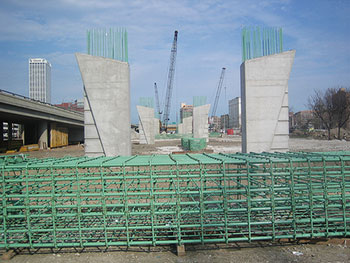Role of reinforcement in construction

When building your house, you want it to not only be beautiful, but also strong. Plain concrete, although strong in compression, is very weak in tension and therefore does not prove to be a very good structural member by itself. However, it can be made extremely useful by reinforcing it with a material like steel, which has the desired ductility and bond characteristics.
The steel reinforcement imparts ductility to concrete, that is inherently a very brittle material. To put it into practical perspective, if an optimally reinforced concrete member were to fail in tension, the ductility of the bars would ensure that such a failure is preceded by a visibly large deformation, giving the occupants plenty of time and warning ahead of the impending collapse.
Phases involved in construction of a house
Construction is a collaborative activity involving the owner, the architect, the structural engineer and the contractor. One may also need to consult specialists for soil investigation, water supply, fire protection, sanitation, HVAC, electrical circuiting, Vastushastra, etc.
The three major phases involved are The Planning Phase, The Design Phase and The Construction phase.

Planning Phase
This phase involves the site selection and conception and planning of the layout by the architect to suit and fulfil the fundamental requirements of the owner. The owner must take into consideration the aesthetic, environmental and economic factors in this stage. Specially, the owner must plan and arrange for the funding that will be required till the completion of the project. To ensure the structural feasibility, a structural engineer needs to be consulted.

Design Phase
Once all the necessary approvals are in place for the preliminary plan, all the specialist consultants need to be engaged to finalize the detailed plan for the structure. All the necessary regulatory requirements and approvals required prior to the commencement of construction need to be in place at the end of this stage.

Construction Phase
This is the single most important and crucial stage in construction where all the plans and designs that have been finalized on paper take concrete form (literally!!). The owner should take care to ensure that only the best quality material is being used for construction as a complete house is one that is not only well planned and well designed, but also well built. All the resources (material, manpower, cash) need to be arranged in time to avoid unnecessary delays. Proper care has to be taken to make sure that the best construction practices are adhered to. The minimum nominal concrete cover to the reinforcement steel has to be maintained in accordance to the relevant IS codes.
Best Construction Practices
If the foundation of your building is poor, then the entire structure will collapse or sink. Keep these
pointers in mind to ensure a strong foundation:
- The foundation should rest on firm soil and it should be taken to a minimum depth of 1.2m from the
ground level.
- If the soil is loose and/or if the excavation depth is more, the sides of excavation should be
supported to prevent it from collapsing.
- The area of the foundation should be sufficient to transfer the load safely to the ground on which
it rests.
- The area of foundation depends on the load carrying capacity of soil. It is important to mark the
location and size of the foundation before excavation.
- Ensure correct marking of the foundations for new walls so that they are the right size and in the
right position to bear the weight of the wall.
- Obtain the layout plan/centre-line drawing from the engineer and establish the centre-line of the
longest outer wall of the building as a reference line between the pegs driven into the ground.
- Mark all trench excavation lines with respect to the centre lines of walls.
- Ensure that the excavation done is true to levels, slope, shape and pattern.
- Consolidate the bed of excavation by watering and ramming. Soft or defective spots should be dug out
and filled with concrete.
- Brace the sides of excavation with tight shoring work for deep excavations to avoid collapsing of
the sides of the excavation area.
Pre constructional anti-termite treatment is a process in which soil treatment is applied to a building
in early stages of its construction. The purpose of anti-termite treatment is to provide the building
with a chemical barrier against the sub-terrain termites.
Termite infestation can weaken structures and damage wooden surfaces. Start the anti-termite treatment
before the construction begins. Here’s what you need to know to keep your home free of termites:
- The soil around the foundation should be treated up to the plinth level with appropriate chemicals.
- The chemical barrier should be continuous and complete.
- Treatment can be done pre, during and post construction stages.
- Care should be taken to ensure that the chemicals do not contaminate the domestic water sources.
Cement readily absorbs moisture from the air if it is not stored properly. The binding property and the
strength of the cement depend upon its capacity for chemical reaction that takes place in presence of
water. Hence, it is necessary to protect cement from dampness and humidity, as it can rapidly lose
strength and form lumps. Here’s how cement should be stored:
- Cement should be stored in water-proof sheds/buildings.
- For temporary storage at sites, cement bags should be stacked on a raised dry platform and covered
with tarpaulins/polythene sheets.
- Avoid manual concrete mixing.
- Keep a close watch on water quantity while mixing.
- Minimum mixing time should be 2 mins.
- Use Admixtures only if required.
- Admixture dosage should be optimum. Do not add more/less quantity.
- Admixture should be first added in water and then can be mixed with other ingredients.
- Mortal Plasticiser should be used only for Mortar and concrete plasticiser for concrete.
- Use good quality Water proofing chemical which should be chloride free.
- Compaction means removing air from concrete.
- It will reduce the voids.
- Lesser the voids, stronger the concrete.
- Proper compaction will ensure Water tightness.
- For manual compaction of slab use Wooden float and 16 mm bar.
Poor quality aggregates will result in inferior concrete thus affecting the durability of the
structure. Here are some handy pointers you need to keep in mind:
- Aggregates should be hard, strong, chemically inert and free from harmful materials.
- If flaky and elongated coarse aggregates are present in excess quantities, it leads to low concrete
strength.
- Cubical and rough textured aggregates are preferred over other types.
- Sand should be free from silt, clay lumps, mica, etc.
- Presence of any of the aggregates in excessive quantities adversely affects the setting, hardening,
strength and durability of concrete.
Your house will not be considered safe if its walls are not strong and sturdy. You need to adhere to
the following tips:
- Bricks/blocks should be laid on a full bed of mortar.
- The joints should be fully filled and packed with mortar.
- Vertical joints should be staggered.
- The brick work should be cured well to make it strong.
Weak and unstable centering and formwork may lead to injuries/loss of life in addition to material
loss. Here’s how centering and formwork should be done:
- Centering should be strong enough to hold the fresh concrete till it hardens.
- To ensure stability, centering should be supported at specified intervals with props that are
adequately braced.
- Gaps between the centering sheets should be sealed to prevent leakage of slurry, which otherwise
would result in honey combed concrete.
Reinforcement bars are a vital component of RCC. It’s important to choose the right steel and place it
right to prevent cracking or even destruction of the RCC members.
- When you’re procuring steel, make sure you get it from a reputed manufacturer.
- Wrongly positioned reinforcement bars are ineffective and lead to the failure of RCC elements.
- While joining the bars, adequate lap length should be maintained and the laps should be staggered.
- Ensure that there is no congestion of reinforcement bars and that the bars have sufficient concrete
cover.
Wall plasters that have unsightly cracks and spoilt interior/exterior finishes are quite common. Here’s
how you can avoid it:
- Plastered surfaces develop cracks and sometimes disintegrate due to lack of proper adhesion.
- Surface preparation plays a vital role in ensuring the adhesion. The surface should be free from any
loose particles, dust etc., and the joints between the bricks/blocks should be properly raked.
- Lean mixes are preferred for plastering as rich and weaker mixes tend to develop cracks.
- Normally, plastering should be done in two coats leaving adequate time between the coats.
Curing is the process of maintaining satisfactory moisture content and temperature in freshly cast
concrete for a definite period of time immediately following placement. The process serves two major
purposes:
- It prevents or replenishes the loss of moisture from the concrete;
- It maintains a favourable temperature for hydration to occur for a definite period.
Dampness or moisture can prove very damaging to any construction. A lot of money can get wasted due to
unexpected seepage of water into walls or woodwork. Sometimes the presence of moisture can even corrode
the steel framework, thus placing the whole structure at risk. In order to safeguard your precious
construction and also to avoid future inconvenience, it is highly important to take strict measures to
waterproof your house. There are various waterproofing techniques that can be used during and after the
construction of the house. It is essential to consult a qualified Engineer or Architect for an
appropriate waterproofing method to be followed in order to avoid subsequent hassles and damage.
Primarily, there are 3 areas of a typical building that need specific waterproofing treatment:
Basement:
- Basement waterproofing can be done internally as well as externally. However for more effective
results, it is advisable to use proper external waterproofing methods during the construction period
itself. Materials such as Kota stone, bitumen and specialised compounds are frequently used for
external waterproofing of the basement.
Terraces:
- Terraces are another area of concern with regard to waterproofing. It often happens in homes that
rainwater or water leaking from the overhead water tanks spoils the flooring of the terrace and even
seeps through the roof of the floor underneath. Before commencing any waterproofing measure for the
terrace, ensure that the structure is complete and the work on rainwater pipes and electric conduits
is over.
Sunken Areas:
- Washrooms and kitchens have a sunken area below the floor that houses the water pipe network. There
is often a presence of water within the sunken areas, and adequate waterproofing is essential to avoid
its seeping through the floor/walls and causing damage to the construction.
If economy is your concern, you can follow these tips to help you save construction costs:
- Avoid complicated forms of shapes.
- Avoid complex system of level.
- Insist on economic structural design.
- Provide maximum possible provision for natural light and ventilation.
- Ensure efficient placement of utilities like water-supply pipes, power cables etc.
- Use fresh, sound and durable building materials.
- Engage trained manpower.
There are a few additional factors that should be considered during construction of the various rooms of the house:
Entrance:
- The entrance is the place to entertain visitors and should be constructed in a visually appealing manner.
- For security reasons, the entrance must be constructed in such a way that it provides adequate protection to the house.
- The entrance also needs to protect the house against inhospitable weather such as harsh sunlight and excessive rains.
Living room:
- The living room should be located near to the entrance.
- The living room should preferably face the lawn, wherever possible.
- Tall windows can add a lot of visual appeal to the living room
Kitchen:
- The kitchen must have adequate ventilation and natural sunlight.
- It should be adjoining the dining room.
- The working platform must be adequately wide and free from obstructions.
- The design should provide adequate space for appliances such as cooking range, dishwasher, chimney etc.
Bedroom:
- The bedroom should be located away from the entrance and living room to ensure privacy.
- The bedroom should be connected with a balcony and attached bathroom, wherever possible.
- Provide adequate storage facilities in the form of almirahs and cabinets.
Bathroom:
- The bathroom must have adequate ventilation and natural lighting.
- The bath fittings and sanitary fittings must be of a high quality to withstand regular and prolonged use.
- The bathroom floor should be 5 cm lower than the other flooring of the house.
Vaastu is an ancient Indian science that works on the principle of Panchbhootas, a term referring to the five basic elements of the universe: Earth, Water, Air, Fire and Space. Vaastu is a science that attempts to achieve a synergy across all the five elements in such a way that the abode becomes favourable to its inhabitants. The optimum use of Vaastu concepts can help one achieve an atmosphere at home that is physically comfortable, emotional soothing and intellectually vibrant.
We have compiled a few Vaastu tips that you can use to enhance the positive effect of elements in various rooms of your home.
General:
- East is the most auspicious direction for entrance to a house.
- The slope of the property should be from west to east or south to north.
- Shadow of a tree should never fall on the house.
- The north direction represents prosperity, and should never be blocked.
- Cactus plant should never be grown in the house.
- All doors should open towards inside.
- Door hinges should be noiseless.
- Columns in a building must be placed in even numbers in any construction.
Bedroom:
- The main bedroom should be constructed in the south-west direction.
- Square and rectangle shape bedrooms are perfect for ensuring peace and prosperity.
- Avoid hanging pictures that depict violence or sorrow.
- Sleep with your head towards South.
Living room:
- The north direction is ideal for the construction of living room.
- Air-conditioners should be in the west and not in the southeast section.
- Southern and western corners of the room are perfect for placing the furniture.
- Dining tables must have even-numbered chairs.
Kitchen
- The ideal location of the kitchen is the southeast corner of the house, with northwest being the second best option.
- Cooking activity should be done while facing east, as it’s an auspicious direction. The other option is north direction.
- Electrical items such as microwaves, juicers and mixers should be placed in the southeast corner of the kitchen.
- The refrigerator should be in the northwest, southeast, south or west.